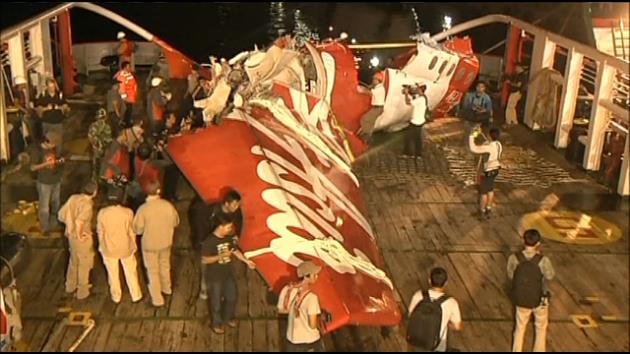By ACHMAD IBRAHIM
Associated Press
PANGKALAN BUN, Indonesia (AP) — Divers retrieved the crashed AirAsia plane’s second black box from the bottom of the Java Sea on Tuesday, giving experts essential tools to piece together what brought Flight 8501 down.
The cockpit voice recorder was freed from beneath the heavy remnants of a wing at a depth of about 30 meters (100 feet), a day after the aircraft’s flight data recorder was recovered, said Tonny Budiono, sea navigation director at the Transportation Ministry.
“Thank God,” he said. “This is good news for investigators to reveal the cause of the plane crash.”
The device will be flown to the capital, Jakarta, to be analyzed with the other black box, a process that could take up to two weeks. Since it records in a two-hour loop, all discussions between the captain and co-pilot should be available.
The plane disappeared from radar less than halfway into a two-hour flight from Surabaya, Indonesia, to Singapore on Dec. 28. It was carrying 162 people, but only 48 bodies have been recovered so far.
The find is the latest boost in the slow-moving hunt in the shallow, murky stretch of ocean.
Over the weekend, the tail of the Airbus A320 was recovered, emblazoned with the carrier’s red-and-white cursive logo. The black boxes are normally inside the tail, but were missing when the wreckage was pulled to the surface.
The devices were soon located after three Indonesian ships detected strong “pings” being emitted from their beacons, about 20 meters (22 yards) apart. Strong currents, large waves and blinding silt have hindered divers’ efforts throughout the search, but they took advantage of calmer early morning conditions on Monday and Tuesday to recover the instruments.
The information obtained from the black boxes — which are actually orange — will likely be vital. Designed to survive extreme heat and pressure, they should provide investigators with a second-by-second timeline of the flight.
The voice recorder captures all conversations between the pilots and with air traffic controllers, as well as any noises in the cockpit, including possible alarms or explosions. The flight data recorder saves information on the position and condition of almost every major part in the plane, including altitude, airspeed, direction, engine thrust, rate of ascent or descent and what up-or-down angle the plane is pointed.
In their last contact with air-traffic controllers, the pilots of the AirAsia jet asked to climb from 32,000 feet (9,750 meters) to 38,000 feet (11,580 meters) to avoid threatening clouds, but were denied permission because of heavy air traffic. Four minutes later, the plane disappeared. No distress signal was received.
Searchers also have been trying to locate the main section of the aircraft’s cabin, where many of the victims are believed to be entombed.
Decomposition is making identification more difficult for desperate families waiting to bury their loved ones. Nearly all passengers and crew were Indonesian.
“I still believe many victims remain trapped there,” said Gen. Moeldoko, Indonesia’s military chief, who uses one name. “And we must find them.”
——
Associated Press writers Niniek Karmini in Jakarta, Indonesia, and Scott Mayerowitz in New York contributed to this report.
Copyright 2015 The Associated Press. All rights reserved. This material may not be published, broadcast, rewritten or redistributed.

